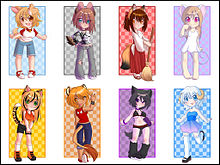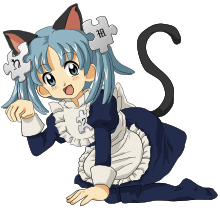Kemonomimi
Kemonomimi or Kemomimi ( Japanese 獣 耳 , "animal ears") is a Japanese term for human-made manga and anime characters with characteristics of animals.
In contrast to Kemono , which in classical Japanese art depict animals with human characteristics and ways of life, Kemonomimi are largely human and only have individual elements of animals (usually animal ears and / or tails).
The models of the Kemonomimi can be found mainly in Japanese mythology . They often have characteristics of cats, dogs or foxes, elements of other animals or of mythical creatures are rarely represented.
species

Cats
Figures with more or less pronounced cat features are called nekomimi (猫 耳, cat ears ). They are among the most famous and popular kemonomimi. Usually they also have "typically feline" traits. A particularly iconic feature is that such figures often incorporate a nyan or nyaa (Japanese for meow ) into their sentences.
While the term is genderless in Japanese, the terms "catgirl" for female characters and "catboy" for male characters have become established internationally for better differentiation. Catgirls are the most common kemonomimi. Catboys, which come more from the Bishōnen genre, are much less common.
In the past, only figures were called nekomimi, in which the cat characteristics were real parts of the body (e.g. cat ears or tail, fur, claws etc.). The term is now also used for figures in which these elements are only artificially attached or are part of clothing, similar to cosplay .
foxes
Figures with more or less pronounced fox features are called kitsunemimi (狐 耳, fox ears ). The models for these kemonomimi are the form-changing kitsune from Japanese mythology.
Rabbits
Based on the Playboy bunnies, the female representatives can be found in many plants. Male forms are rather unusual.
Dogs and wolves
Faithful "dog girls" are less common than cat girls. However, there is a great variety of "dogboys", mostly in girl-oriented works such as Shōjo , Shōnen Ai and Yaoi . The most famous representative is Inu Yasha in the manga and anime of the same name.
Wolf girls and boys tend to be wilder, but are rarely used. A typical example of this is the light novel series Ōkami to Kōshinryō , which is about a love affair between a simple merchant and a wolf goddess.
Rats and mice
A rare but encountered species of Kemonomimi are rodents, which are sometimes used as an antipole or as prey by catgirls.
use
Cosplay
Catgirls (own creations and original characters) are a popular topic when choosing a cosplay .
mascot
Many anime conventions use kemonomimis or animals as mascots. (including Anime no Tomodachi , AniNite ).
Characters in comics, cartoons, and video games
Many animes (e.g. Fam in Ruin Explorers), mangas (e.g. Schrödinger in Hellsing ) and games (e.g. Felicia in Darkstalkers) contain catgirls or other kemonomimi. Mostly they take on the role of the fool or a general comedic character.
Furry
Drawn, anthropomorphic animal figures are a major part of the Furry -Fandom. Sometimes bonds from the Kemonomimi are used for this.
Idols
Some Japanese idols and models are dressed as catgirls on pinups . The American Lisa Batey often wears cat ears in her Lifecast show Nekomimi_Lisa .
further reading
- Christopher Hart: Draw and paint chibi manga: cheeky mascots, cute mini-people and cool cat girls; with numerous step-by-step illustrations . Knaur, Munich 2006, pp. 50-85, ISBN 978-3-426-64410-2
See also
- anthropomorphism
- Domestic cats in comics and cartoons
- Kemono
- Style elements of manga and anime
- Huldra

